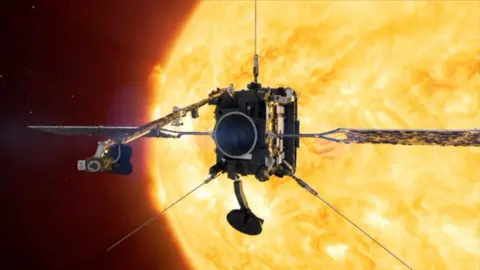Science videographer
The first ever video and images of the Sun’s south pole have been sent back to Earth by the European Space Agency’s Solar Orbiter spacecraft.
The new images will enable scientists to learn how the Sun cycles between periods of raging storms and quiet times.
This is important because intense solar activity can affect satellite communication and knock out power grids on Earth.
The new images show a shimmering bright atmosphere which in parts reaches temperatures of a million degrees Celsius. Interspersed are darker clouds of gas, which although much cooler, are still a searing one hundred thousand degrees.
The pictures are the closest and most detailed ever taken of the Sun and will help scientists learn how the star that gives us life on Earth actually works, according to Prof Carole Mundell, ESA’s Director of Science
“Today we reveal humankind’s first-ever views of the Sun’s pole,” she says.
“The Sun is our nearest star, giver of life and potential disruptor of modern space and ground power systems, so it is imperative that we understand how it works and learn to predict its behaviour”.
From Earth, the Sun is so bright that it appears like a featureless disc. But at different frequencies and using special filters, scientists can see it in its true form: as a dynamic fluid ball, with magnetic fields twisting and turning on the surface and conjuring up flares and loops of gas into its atmosphere.
It is these magnetic fields that determine when the Sun rages and spits out particles toward the Earth.
Scientists know that the Sun has a quiet period when the magnetic fields are ordered, with our star having a fixed magnetic north and south pole. This is a phase when the Sun is not able to produce violent explosions, but these fields then become complex and chaotic as they reorientate with the north and south poles flipping approximately every 11 years.
During the chaotic period the Sun tries to reduce its complexity and violence spills out, as bits of the Sun hurtle toward the Earth. These solar storms can damage communications satellites and power grids, though they can also cause beautiful auroras in the sky.
According to Prof Lucie Green of UCL, it has been hard to predict this activity with computer models of the Sun because there has been no data on the migration of the magnetic fields towards the poles. But that has now changed
“We now have the missing piece of the puzzle,” she told BBC News.
“The reversal of the polar magnetic fields on the Sun has been one of the big open questions in science and what we will be able to do with Solar Orbiter is measure for the first time the really important fluid flows that grab pieces of the magnetic field across the Sun and transport them to the polar regions”.
 ESA
ESAThe ultimate goal is to develop computer models of the Sun so that this so-called space weather can be predicted. Accurate forecasts will enable satellite operators, power distribution companies, as well as aurora watchers, to better plan for intense solar storms.
“This is the Holy Grail of solar physics,” says Prof Christopher Owen, who specialises in solar wind studies using data from the spacecraft.
“Solar Orbiter will enable us to get to the bottom of some of the basic science of space weather. But a little more work needs to be done before we get to the point where we see signals on the Sun that we can rely on to predict eruptions that might hit the Earth”.
 ESA
ESASolar Orbiter also has captured new images of chemical elements at different layers of the Sun and their movement. These have been taken using an instrument called SPICE, which measures the specific frequencies of light, called spectral lines, which are sent out by specific chemical elements hydrogen, carbon, oxygen, neon and magnesium at known temperatures.
For the first time, the SPICE team has tracked spectral lines to measure how fast clumps of solar material are moving. These measurements can reveal how particles are flung out from the Sun in the form of solar wind.




